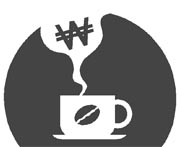Korean coffee prices defy market logic

Starbucks was the company that in the 1980s introduced Italian-style coffee to Americans, who were accustomed to drinking drip coffee. It took its business model from Italian cafes.
Not all coffee is the same. Like wine, the price and taste of coffee vary greatly depending on the area where it is produced.
There are two major species of coffee - Arabica, which makes up about 75 percent of total global output, and Robusta, which is lower in grade than Arabica but has more caffeine. They are priced according to quality: Jamaican Blue Mountain, Hawaiian Kona, Colombian Mild, non-Colombian (such as Guatemalan, Yemeni and Ethiopian), Mild Arabica, Brazilian Arabica and Robusta from Java. Blue Mountain coffee, the production of which is only about 1 percent of the total output, is rare and much more expensive than other varieties.
Korea has become a big coffee importer. Last year, Korea imported a total of $420 million worth of coffee, the largest amount in history. That is equivalent to each of the 37 million Koreans over the age of 20 consuming 312 cups of coffee a year.
A few days ago, the Korea Customs Office announced that the import price of 10 grams of coffee was 123 won ($0.11). If coffee houses charge over 3,000 won for a cup of coffee, they’re make a profit that is more than 20 times the wholesale import price. Even considering a coffee shop’s rent, processing and wages, consumers may feel they are being cheated when they compare the price of coffee to its taste.
In Korea, consumers’ tastes are diverse. Some still get coffee from vending machines while others prefer to drink brewed coffee. But a weird coffee war is being waged here between local and foreign brands. When the competition between the brands heats up, prices should go down, according to the rules of economics. But it’s the opposite in Korea.
Coffee is not nearly as expensive in Western countries as it is here. In Europe, it costs 1 euro ($1.38) for an espresso at a take-out coffee shop. In the United States, too, coffee is not as expensive as it is here. We should investigate whether the high price of coffee is legitimate or whether it’s nothing more than a tasteless sales gimmick.
*The writer is an editorial writer of the JoongAng Ilbo.
By Ko Dae-hoon










with the Korea JoongAng Daily
To write comments, please log in to one of the accounts.
Standards Board Policy (0/250자)